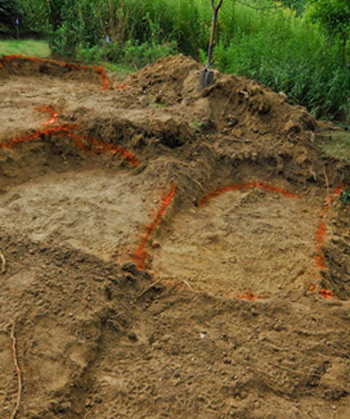Pond-Free 103 Chapter 4
Creating Streams

Plan out a rough idea of the height of the drops or falls that you want for your stream or falls, and sculpt the excavated soil or existing hill into a series of broad shelves, much wider and deeper than you intend for the finished stream or waterfall. If possible, you can use a single piece of liner for the excavation, but overlapping the stream liner over the pond liner at a shelf is perfectly acceptable as long as both liners are well above water level and the overlap is vertical. Wide shelves will give you plenty of room to set rock and let the stones themselves form the curves and lines of the water course. It’s far easier to meander back and forth from side to side with rocks setting the course of the stream or falls, then backfill behind the liner afterwards, than to carve a narrow channel and have to keep excavating to make boulders fit.

Plan out a rough idea of the height of the drops or falls that you want for your stream or falls, and sculpt the excavated soil or existing hill into a series of broad shelves, much wider and deeper than you intend for the finished stream or waterfall. If possible, you can use a single piece of liner for the excavation, but overlapping the stream liner over the pond liner at a shelf is perfectly acceptable as long as both liners are well above water level and the overlap is vertical. Wide shelves will give you plenty of room to set rock and let the stones themselves form the curves and lines of the water course. It’s far easier to meander back and forth from side to side with rocks setting the course of the stream or falls, then backfill behind the liner afterwards, than to carve a narrow channel and have to keep excavating to make boulders fit.




